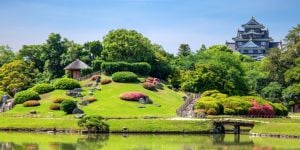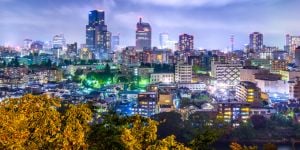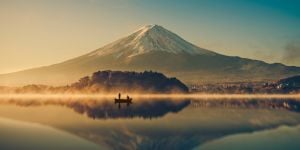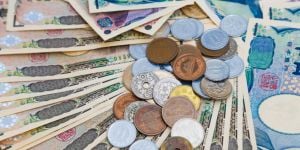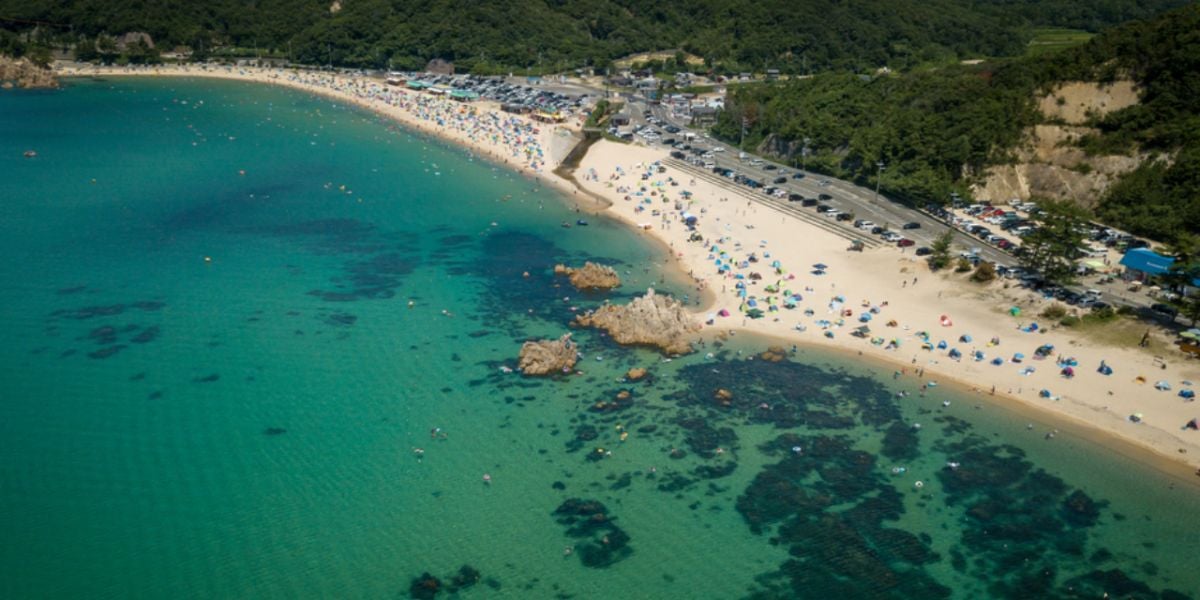
Located in the North-east of the Chubu region on the island of Honshu, Fukui Prefecture, Fukui-ken, where ken means "prefecture" or "county" in Japanese, gave its name to its capital, Fukui-shi, with shi meaning "city" in Japanese. Fukui borders Kyoto Prefecture to the Southwest and Gifu Prefecture to the Southeast. Its northern shores meet the Sea of Japan. What are the other characteristics of Fukui? Let's discover the prefecture.
Overview of Fukui Prefecture
Located Northeast of Kyoto Prefecture, North of Shiga Prefecture, Northwest of Gifu Prefecture, and Southwest of Ishikawa Prefecture, Fukui Prefecture is home to 743,386 inhabitants as of January 1, 2024. Most of them live in Fukui City, the capital. The capital counts 256,363 people and tops the other big city, Sakai, home to 86,512 inhabitants.
Fukui Prefecture has various industries, including textiles, machinery, and eyeglasses. These industries are incorporating advanced technologies due to rapid technological innovation.
Technoport Fukui is one of the largest industrial parks in the Kinki and Chubu areas, spanning Fukui City and Sakai City, and aims to support the growth and revitalization of these industries.
Also, the opening of the Hokuriku Shinkansen in March 2024 will improve access from Fukui to Tokyo and Osaka, shortening the travel time to 2 hours and 51 minutes.
Regarding agriculture, Fukui is renowned for producing high-quality rice, such as Koshihikari. Additionally, Fukui Prefecture plays a crucial role in supplying energy to the Kansai economic zone through its numerous nuclear power plants (source: Fukui Prefecture Website).
The cities of the Fukui Prefecture
There are 17 cities and towns in Fukui Prefecture: Fukui City, Sakai City, Echizen City, Awara City, Ono City, Obama City, Katsuyama City, Sabae City, Tsuruga City, Ikeda Town, Eiheiji Town, Echizen Town, Ooi Town, Takahama Town, Minamiechizen Town, Mihama Town, and Wakasa Town.
Our first stop is in Tojinbo Cliffs in Sakai City. In the extreme Northwest of the prefecture lies the awe-inspiring rocky coast facing the Sea of Japan. The roughness of the waves has produced this unique landscape, and the battered cliffs extend along the beach for nearly one kilometer. The site is classified as a natural landmark.
Also, you can find Maruoka Castle in the North but deeper inland. Located in the city of Sakai, it is the oldest castle tower in Japan. Matsuyama, a little more to the West, hosts the Fukui Prefectural Dinosaur Museum, one of the world's most famous.
Further West, the scenery becomes mountainous, with mounts Kyogatake, Nobusegatake, and Arishima in Ono City. Down South lie the coastal cities of Tsuruga, Mihama, Obama, Ooi, and Takahama. The discreet Mount Obama was brought into the limelight with the election of Barack Obama. Hence, the city's inhabitants openly support the American ex-president.
The economy of Fukui
The prefecture is home to significant specialty companies ranking top 1 in domestic and global share in various industries, including textile, chemistry, plastic, ceramic, machine/metal, glasses, electric/electron, ITC, and traditional crafts. These companies take advantage of the prefecture's location (by the sea) and its infrastructure (Fukui port, airport) to trade with all of Southeast Asia and the world.
List of some No.1 domestic shared companies by industry in Fukui Prefecture:
Textile
- Urase Co., Ltd.: Black deep color processing in polyester fiber dyeing;
- Kuraray Fastening Co., Ltd. Maruoka Factory: Velcro fastener “Magic Tape®”;
- Kosugi Textile Co., Ltd.: High-density multicolor pattern seamless yukata obi;
- Sakai Ovex Co., Ltd.: Mid-level pelagic reef;
- Sankei Co., Ltd.: Dyeing of lining is essential for clothing manufacturing;
- Takeda Lace Co., Ltd.: Lace for innerwear (product name: Folpo lace, Lacey River lace, Lux lace);
- Toyo Senko Co., Ltd.: Dyeing and finishing of ultra-thin knit fabric;
- Fuji Ware Hen Co., Ltd.: Medical white coat (nursing coat);
- Maeda Kosen Co., Ltd.: Weather-resistant large sandbag “Two-Tone Bag®”.
Chemical
- ITEC Co., Ltd.: Glass frame surface treatment, ion plating processing without contact;
- NCC Co., Ltd.: Optional color emblem for all HONDA models (gold, black);
- Kanbou Plus Co., Ltd. Fukui Factory: Construction sheet;
- Japan Polymark Co., Ltd.: Various caution labels (notes) displayed on cars;
- NICCA CHEMICAL CO., LTD.: Fluorine-free water repellent for textile processing “NeoSeed®NR Series”, water-based urethane resin for artificial leather “Evaphanol Series”, flame retardant for textile processing, “NIKKAFINON, NEO STICKER” series, dry cleaning detergent “Drystar WP-1”;
- Nissin Chemical Industry Co., Ltd.: Wallpaper matting agent (product name: Vinibran).
For more information, visit Fukui Prefecture website to search for companies by industry.
The history of Fukui Prefecture
The late 15th and early 16th centuries marked the end of the Sengoku era. Commander Katsuie Shibata took control of the Echizen province. With it, he conquered Fukui and turned it into a fortified city.
The Kitanosho castle, which was the symbol of this prosperous era, was destroyed by the commander Shibata himself after his defeat at the battle of Shizugatake in 1553. In those times when honor was as meaningful as life, it was inconceivable for the commander to leave his castle, his secrets, into the hands of the enemy. He committed suicide and destroyed the luxurious building. It was the end of an era.
The region's revival only came by the beginning of the 12th century, when Lord Yuki Ideyasu, son of Shogun Ieyasu Tokugawa, instilled new life into the noble castle. Unfortunately, a big fire ravaged the newly rebuilt building. Whatever remained of the castle survived until the Meiji era before disappearing for good. Thankfully, some parts of the ruins can still be seen today.
Tourism in Fukui
With its lush vegetation and protected areas, Fukui has many assets to attract tourists. However, the city aims to develop a reasoned and responsible sector instead of mass tourism.
The cliffs of Tojinbo, the Ichijodaki waterfalls, the famous Aobayama mountain, the historical road of Kumagawajuku, and the waterfalls of Uriwarinotaki make up a long list of treasures of the Fukui prefecture. The trip then continues with the traditional shrines and temples, like Eiheiji temple, Echizen Great Buddha, Kehi Shrine, or Wakasahiko shrine, all places full of history.
The trip to Fukui is also a culinary one. The city of Echizen is famous for its crab (Echizen-gani) and soba (buckwheat noodles) called Echizen-oroshi. In Mihama, one can also taste the "fine blue eel", caught and prepared afresh. Fukui is also known for its katsudon (breaded pork chop), the secret of which lies in the sauce.
If you are on a shopping spree, check out shopping malls such as Maruoyaka, Fukusoba, Takaiya, Echizen-suisan, or Santan to discover Echizen's soba, persimmon chips, and cakes, or even spit cakes.
Useful links:
Websites in English:
Fukui Prefecture official website
Websites in Japanese:
City of Obama (translation available in Korean, Chinese and English).
We do our best to provide accurate and up to date information. However, if you have noticed any inaccuracies in this article, please let us know in the comments section below.
